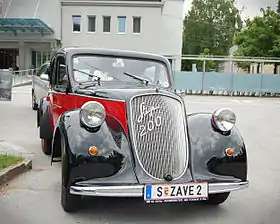Steyr 100
The Steyr 100 and 200 were a series of medium-sized cars built by the Austrian manufacturer Steyr-Daimler-Puch AG from 1934 to 1940. The four-door streamlined body designed by engineer Karl Jenschke was manufactured in Steyr, a 1933 prototype was assembled by Gläser-Karosserie GmbH in Dresden, Germany.
| Steyr 100, 200 | |
|---|---|
 | |
| Overview | |
| Manufacturer | Steyr-Daimler-Puch AG |
| Production | 1934–1936 (100): 2,850 built 1936–1940 (200): 5,040 built |
| Assembly | Steyr, Austria |
| Body and chassis | |
| Class | Small family car |
| Body style | 4-door sedan 2-door convertible |
| Layout | Front-engine, rear-wheel-drive |
| Powertrain | |
| Engine |
|
| Transmission | 4-speed manual |
| Dimensions | |
| Wheelbase | 2.60 m (102 in) |
| Length | 4.37 m (172 in) |
| Width | 1.61 m (63 in) |
| Height | 1.55 m (61 in) |
| Curb weight | 950–1,000 kg (2,090–2,200 lb) |
Design

The cars had a four-cylinder straight engine and a four-speed manual gearbox driving the rear wheels on a leaf spring suspension, reaching a maximum speed of about 100 km/h (62 mph). Though not high-powered they could easily climb the Austrian Alpine mountain passes, demonstrated by the Salzburg governor Franz Rehrl, when on 22 September 1934 he and engineer Franz Wallack travelled the Grossglockner High Alpine Road driving a Steyr 100, about one year before the official opening. In 1935-36 the Austrian travel writer Max Reisch crossed Farther India (Burma, Thailand, and Laos) in a Steyr 100 and continued his journey through the United States.
After 2850 vehicles built the design underwent improvements in 1936, creating the more powerful Steyr 200. One technical novelty for the 200 model was the starter motor, which also doubled as an alternator. The 200 also received an updated body, with a somewhat larger (still split) rear windshield. 5040 such vehicles were produced until 1940.